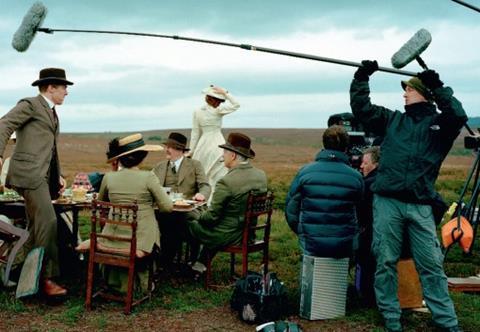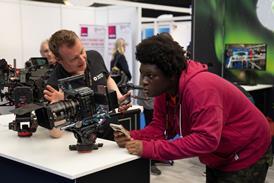Despite the best efforts of location sound recordists and mixers, extraneous noise can sometimes make it to post. Four experts reveal their tools and techniques for getting rid of the unwanted hums, clicks and pops.

Dave Ashton, supervising dialogue editor, Galaxy Studios, Belgium
The extent to which audio restoration tools are needed, and which ones are used, can vary at different stages of the audio post process.
“You need to know your place in the chain and how much manipulation you’re doing,” says dialogue editor Dave Ashton.
“You also don’t want to limit the mixer’s options because there’s another layer of denoising that will happen in the mix, where they use Waves and Cedar DNS1.”
Ashton’s main audio repair tool in his room at Galaxy Studios in Mol, Belgium, is the iZotope RX suite of programs, which he runs in standalone mode.
“It offers a lot more control over what you can do and has the ability to open all the plug-ins at the same time. You can take one piece of audio and really go to town on it, declicking, denoising, doing a whole bunch of stuff.”
Ashton worked on 2012 BBC/HBO coproduction Parade’s End, on which there was a problem with a night scene set in the countryside but shot in a studio.
“You could hear the reverberation from the room,” he says. “Using SPL De-Verb subtly we were able to bring down the reverberations enough so it didn’t sound like it was in a studio any more.”
Parade’s End threw up other problems, including noise from fireplaces and explosions during battle scenes.
These were dealt with using iZotope, which was recently updated with the addition of Ambience Match. This allows editors to take a small section of background sound and loop it to the required length.
Ashton says editing is usually his starting point: “The first thing I would try is to edit together actual background sound, using different takes to build up as long a piece as I can.
“But when that’s not possible, you’ve got another option. It’s about keeping your options open and getting the cleanest track possible in the best way. Edit first, clean after.”
Glenn Calder, managing partner and dubbing mixer, Jumbuck Film and Television
“Dialogue is the most important thing in a show. It has got to be as good as possible,” says Glen Calder, whose audio-only post house Jumbuck works on a range of productions, from TV comedy and drama to feature films.
Poor mic placement can result in audio tracks that are too quiet or have a lot of background noise.
When such material is received at Jumbuck’s premises, it is worked on using Waves and iZotope audio restoration plug-ins. Calder says the Dialogue Denoiser in the iZotope RX and RX Advanced suites of tools is often used instead of ADR (automatic dialogue replacement).
“It can be hard to match the original sound but ADR can stand out if it’s not done right,” he says.
“The Dialogue Denoiser is basically a spectrum analyser that looks at the audio and works out what is the spoken element and what is noise.”
This came into play on an episode of Big Talk’s The Job Lot for ITV, part of which was shot beside a motorway.
Calder acknowledges there is only so much plug-ins can do, with distortion from overrecording being an obvious example.
“We can’t always take that out but it’s a challenge for plug-in upgrades and there’s nothing to say we won’t be able to in the future.”
Ross Millership, dubbing mixer, Envy Post
“Clicks, crackles, hums from lights and distortion are fairly standard,” says Ross Millership. “We get clipped audio that distorts on reality series and documentaries. Sound recordists do leave headroom but if someone suddenly shouts it will go over.”
Another common problem is reverberation in bare rooms. To deal with this, he uses the Zynaptiq Unveil de-reverberation and signal focusing plug-in.
“The designers are magicians because it deals with it so well,” he says. “You can see all the artefacts before you start and push reverb much harder.”
Hums are dealt with by the McDSP NF575 noise filter, which Millership describes as “very good and 100% transparent”.
The ubiquitous iZotope, in the form of RX Advanced, takes care of clicks and crackles but also plays a part in fixing more esoteric faults.
Its Spectral Repair function helped save a reality show soundtrack that had been ruined by gulls.
“Two people were having an argument and seagulls in the background destroyed the feeling of the scene,” Millership says.
“But Spectral Repair allowed us to forensically paint them out without affecting the subject.” Some faults, Millership concedes, are less easily solved by plug-ins:
“Radio mic rustle can be a problem. If it’s not over dialogue we can take it out and put in some ambient sound, but if it is over speech we can’t remove it. Apparently a de-rustle program for plug-ins is not far away.”
Ben Vavangas, dubbing mixer, Evolutions
Background noise is nothing new but ‘fixed-rig shows’ like Channel 4’s Educating… series, on which the dialogue of secondary characters is captured by microphones in fixed positions, have heightened the problem.
“Having mics open like that picks up a lot of room noise and how we deal with it depends on what kind of sound it is, such as air conditioning or hums,” explains Ben Vavangas.
In dealing with such artefacts, Vavangas says his “first port of call” is equalisation, a fi ltering process found on both mixing desks and Pro Tools that is used to compensate for any introduced distortion or to increase or reduce high, mid and low frequencies.
“I roll off the bass or notch out certain frequencies,” he explains. “A lot can be done with dialogue noise using EQ.”
When EQ is not enough, Vavangas turns to either Waves or iZotope plug-ins.
“The iZotope RX3 is easy to use and has excellent declicking and decrackling features, and the WNS [Waves Noise Suppresser] has a lot of different EQs,” he says.
“We have Focusrite units as well, but it depends on preference. I think it’s better to try lots of units because they all have different algorithms and deal with things in different ways.”
The ideal, Vavangas says, is to concentrate on sound design rather than noise problems, but plug-ins help where there are specific difficulties.
“The layman doesn’t generally notice, especially if they’re not listening on good speakers, but it is important to get the sound as good as it can be with the tools we’ve got,” he says.




























No comments yet